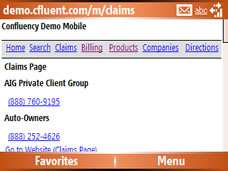How many contacts does it take before you close a sale and capture a new customer for your agency? Take a look at your most successful sales people and you will find that they systematically finesse a prospective account with multiple contacts. They use those contacts to build buyer confidence through an incremental process - each conversation or email reinforces or the agency value proposition until finally the prospect wonders why they didn't consummate the buying decision sooner.
The right number of touches will vary with account complexity, whether you are dealing face to face or through cyber space and familiarity of the prospect with your agency. Eighty percent of all sales happen after the fifth touch but a purchased lead will require more than five reinforcing contacts. You can't make everyone in your agency a top producer but you can improve close rates for all by providing a system for follow up and by making proactive contacts easy and non-threatening for the more timid.
Delivering a requested quote, the first contact, is easy. You can make the next two to four contacts just as easy by using email to introduce other products and to create an awareness of less obvious exposures (recognizing and solving a problem). Those emails should include links back to your agency web site where prospects can access various resources and sample the convenience and expertise your agency provides. A phone call to make sure the prospect got the email and to see if they have any questions removes the sales pressure from additional contacts.
The key is to prepare email copy ahead of time and to define a standard contact schedule when prospects are quoted. You can view a sample flight of emails for a personal auto insurance prospect byclicking here. Feel free to use the email text as you see fit.
Google has come to expect a drop off in traffic during the summer. Vacations and outdoor activities have traditionally kept people away the internet access that consumers need to get to Google's products and applications. But this summer was different. A big boost in use of Google's mobile web products like search and Google maps offset much of the summer slump.
and applications. But this summer was different. A big boost in use of Google's mobile web products like search and Google maps offset much of the summer slump.
Between May and June of this year Google's mostly US based mobile traffic increased 35%. Other sites have recognized the demand for mobile device formatted pages and especially for cell phone and PDA based browsers. Just days before this article was published the social networking web site Myspace announced a version of the site especially for cell phones. In their struggle to prevent defections to rival FaceBook MySpace understands that accessibility in more places than just the desk top or lap top means more users.
Several of the more popular mobile web destinations are listed at the end of this article. Your insurance agency web site could and should be among them. What a great way to demonstrate to customers and accounts you quote that your agency is dedicated to customer convenience and accessibility.
(These sites are best viewed with your cell phone or PDA)
Sample insurance agency mobile website:http://demo.cfluent.com/m
Other popular mobile web sites:
Wall Street Journal
http://mobile2.wsj.com/device/index.php
Edmunds New and Used Car Information
http://pda.edmunds.com/
Business Week
http://pda.businessweek.com/index.html
Traffic.com
http://mobi.traffic.com/traffic/
Google Maps
http://google.com/gmm/index.html
Orbitz for flight updates and hotel reservations
http://mobile.orbitz.com/
IBM released a study late this summer suggesting that a minority of policyholders feel their insurance program is tailored to their specific needs and less than 50% believe they are informed about new products and services available through their provider. The study goes on to assert that insurance carriers need to diversify their distribution channels if they are to drive organic growth, a glaring issue, and meet the demands of baby boomers and younger consumers.
That may be. But the phrases 'alternative distribution' and 'diversify distribution channels' are almost always code words that have come to mean 'market directly via the internet'. Insurance consumers do want choices for fulfilling insurance needs but they don't necessarily desire an alternative distribution. Insurance companies, once rate increases wane, historically become desperate for growth sources. But as long as independent agents can provide what consumers want during and after business hours and continue to be a compelling provider of insurance services there is no need for consumers or carriers to look elsewhere.
Insurance companies have a responsibility to find ways to help their agents supplement their service capabilities. Many companies have done that by providing service center alternatives and web based transaction capabilities (billing, policy document access, etc.). Continued company investment in supplemental sales and service alternatives is vital to the health of the independent agency distribution. But independent agents cannot rely on the companies to do everything. Insurance agency exploration and investment in sales and customer development programs will stave off a carrier migration toward direct distribution.
As an alternative to going direct many companies will increasingly differentiate compensation and support, providing the highest levels of both for those agencies that are most responsive to market place demands. Your agency, particularly through councils and personal relationships, can have an influence on individual insurance company distribution decisions. By demonstrating a commitment to sales and product promotion and using 'alternative channels' to find and service new customers your agency will stabilize income. And you just may prevent a key agency partner from becoming your competitor.

